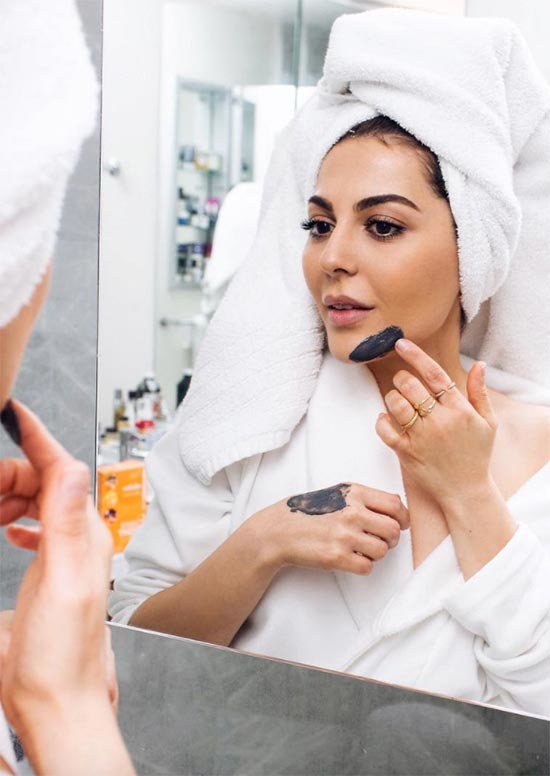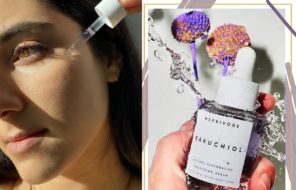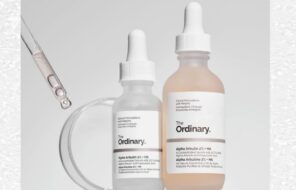Clay is a holistic resource that taps into the nuances of the natural and mineral world to provide organic benefits for human skin. Though it may seem like an alchemist’s magical blend the real strength of clay is that its power is drawn from its earthbound detoxifying and purifying qualities.
In today’s world, we are exposed to an array of environmental toxins such as air-borne pollutants and irritants. Clay is the earth’s natural salve for these maladies. Clay is a naturally occurring compound rich in beautifying minerals, like silica, calcium, magnesium, and potassium. It can be sourced in soil, volcanic ash, and ancient sediment.
Clay masks improve skin tone because they rid the skin of environmental toxins and improve skin circulation and the production of collagen. Clay masks promote the removal of pore-clogging dirt and amp up the production of beautifying silica, which ultimately leads to glowing skin.
Today, we will explore the benefits of clay masks and will offer tailored suggestions for your skin type.
In this article:
- How Do Clay Face Masks Work?
- Clay Mask Benefits
- Different Types of Clay for Skin Care
- What Are the Differences Between Clay and Mud Masks?
- How to Use a Clay Mask?
How Do Clay Face Masks Work?
Clay has been used throughout history for its soothing and polishing qualities and for the benefits that can be accrued from incorporating it into your skin care routine. Documents indicate that clay was used as a topical solution as far back as Ancient Rome.
Clay is comprised of the natural minerals and elements of the earth, making it an accessible and abundant resource, which can have undeniable healing effects on human skin. By the nature of their skin-clarifying constituents, clays are perfectly positioned to aid you in the journey toward clearer skin.
Clays naturally detoxify the skin by drawing out impurities and excess oils and dirt. Clays are rich in minerals and acids that impart your skin with a polished texture and consistency without the addition of harsh chemicals or stringent ingredients.
Clay effectively targets three of the most common skin concerns: inflammation, bacterial imbalance, and toxicity. Clay draws out toxins from the surface of the skin, as it effectively binds to metals like lead, mercury, and cadmium, which can be found in trace quantities within the skin.
Environmental pollutants and dirt bind to clay, and their removal leads to more clarified and angelic skin. Clay is naturally negatively charged and when it interacts with positively charged heavy metals, it clings to them and allows you to wash them off in one soothing motion. The negative charge of clay means that it requires an oppositely charged ion to bind to, so clay seeks these free radicals out by the nature of its molecular build.
Bentonite clay, a variety of therapeutic topical clay, produces a negative electric charge when introduced to liquid. The ‘activated’ bentonite clay will bind to the toxins present in the liquid and will draw them out – this results in an antioxidant effect, which reduces inflammation and irritation.
In addition to its molecular structure, clay also contains a wealth of healing and nourishing minerals and elements, drawn directly from the earth. These skin-loving minerals include magnesium, copper, calcium, sodium, copper, silica, potassium, and iron. These minerals boost the moisture profile of your skin and hydrate to create a softer and clearer texture.
The combination of the naturally occurring minerals also works to balance the microbial environment of your skin, which reduces sensitivity and can work to combat breakouts and redness. Clay masks have astringent properties that are proven to minimize redness and blemishes.
Clay Mask Benefits
There are so many benefits to clay masks, you are going to make them an integral part of your regular skin care routine. These are some of the reasons why you’ll fall in love with clay masks!
Clay Masks Are Perfect for All Skin Types
Clay masks have a wealth of benefits for all skin types, ranging from oily, dry to sensitive. Clay is also a wonderfully soothing option for aging skin, and can be used in the construction of a more youthful and supple skin appearance.
Clay masks are salient players in the fight against oils. One of their most touted benefits is the holistic way in which they soak up excess oil and grease. Clay masks are extremely beneficial for women with oily skin for this purpose.
Often we use harsh toners to soak up excess oil but this often has the unintended effect of drying out our skin and promoting the production of more oil to make up for the moisture that has been stripped. Clay is a gentler alternative that won’t aggressively dry out the skin’s surface.
Clay masks offer detoxifying and clarifying benefits for women with dry skin, as well. Clay mask products formulated with glycerin and sodium hyaluronate are particularly good choices for ensuring that your skin is left supple rather than rough after a treatment.
Ensure that you are following up your clay mask application with a heady dose of moisturizer to ensure that you lock in the beneficial qualities of the mask while maintaining a smooth and hydrated texture.
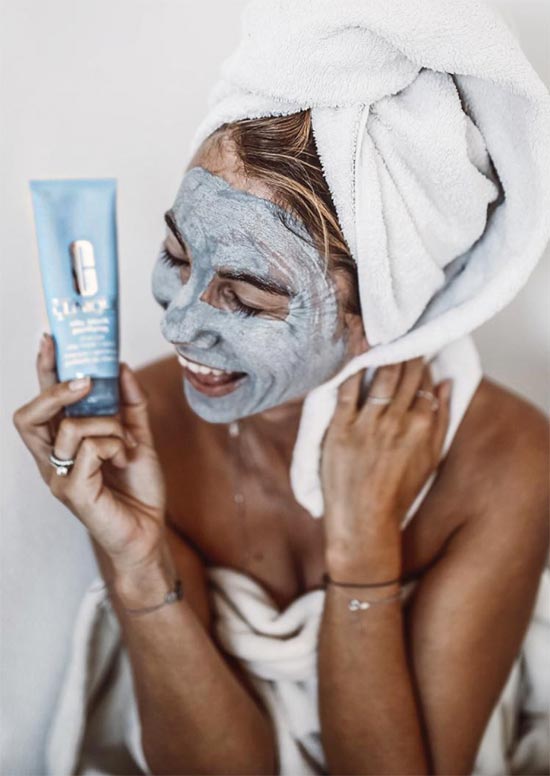
Silica the Savior!
Clay includes the nourishing ingredient silica. Silica promotes the growth of connective tissue and aids in the production of collagen, which keeps skin looking supple and youthful. The decrease of collagen over time is responsible for the development of wrinkles and deep lines, so silica is a key player in the maintenance of fresh-looking skin.
Silica is highly beneficial in staving away wrinkles for women with drier skin profiles. The silica in bentonite clay is specifically effective, as it promotes blood circulation by deeply oxygenating the skin. Increased circulation ensures that the creation of new skin cells will be more rapid and collagen binds will be formed more aggressively.
Clay Absorbs Impurities
Because clay attaches to toxins and bacteria, it cleanses the skin of potentially harmful elements and creates a brighter and fresher skin surface. Excess bacteria can seep into the skin and dull its consistency and tone. Clay will soak up the bacteria and oils that impede consistent skin quality.
Excess bacteria and pathogenic materials inflame the skin and are leading causes of acne and blackheads. Clay removes this buildup and in the process reduces facial impurities and skin infections like psoriasis and eczema.
Many women with sensitive skin types experience flare-ups and redness when exposed to environmental pollutants or airborne toxins, and clay is a soothing and gentle way of soaking up these irritants.
Clay masks also replenish and rejuvenate skin by sloughing away rough, dead skin cells. The result of clay’s absorption properties? Your skin will feel tighter, clarified, and rejuvenated.
Clay Oxygenates the Skin
Clay masks oxygenate the skin by absorbing hydrogen molecules from the cells of the skin. The removal of hydrogen leads to fresher and brighter skin by improving the circulation of the skin cells and amping up the removal of dead skin cells. This results in youthful and vibrant skin.
As clay masks soak up oil and oxygenate the skin, they also impart the skin with a cocktail of nutrients and minerals. Clay masks give as much as they take!
Clay Reduces Pores
Because clay is so effective at clinging onto oils and sebum, it has the desirable effect of reducing pores. Smaller pores create a clearer and more flawless skin canvas and are one of the hallmarks of stunning and healthy skin. Pores become enlarged with dirt, pollutants, and oils, and this leads to blackheads and breakouts.
As the clay mask absorbs these impurities, the pores on the surface of the skin contract. This is particularly effective for blackheads, one of the most visible signs of clogged pores. Frequent use of clay masks will lead to an organic reduction of pores in time.
The generous use of clay over time will result in a more exuberant-looking skin tone. Not only does clay work to remove sebum and oils, but also it can aid in reducing their production in the first place.
Excess oil production can be owed to both external irritants and the immune response to stress, infections, and bacteria. Frequent use of clay masks removes oils and irritants that would otherwise seep into the skin and wreak havoc on your immune system. When paired with a healthy diet, clay can work to reduce the incidences of skin breakouts over time.
Different Types of Clay for Skin Care
There are three families of popular clay mask products: green, red, and white clay.
- Green clay contains the highest mineral content and it is a potent method of absorbing oil and sebum buildup.
- Red clay is of a kaolin variety and contains a higher quantity of silicate. Red clay is rich in iron oxides, which rejuvenate the skin and dissolve dead skin cells.
- White clay is less absorbent than the former two making it an ideal option for women with sensitive skin.
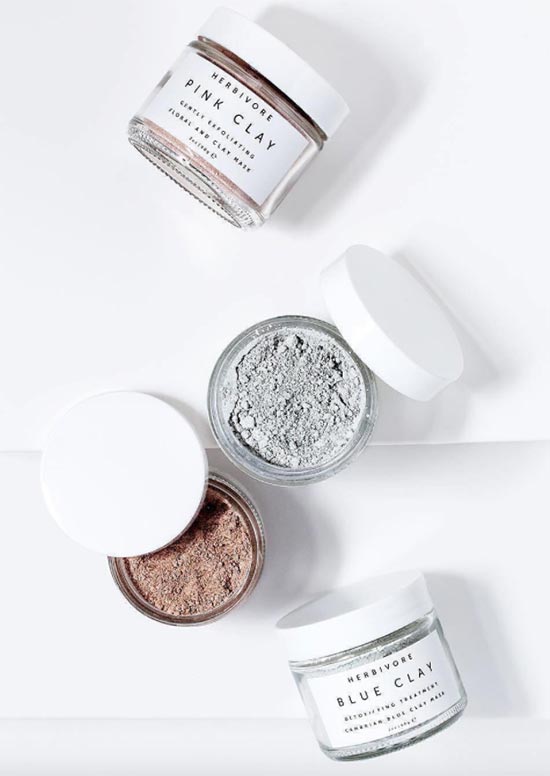
Bentonite Clay
Bentonite clay has the most significant absorption properties and is the best choice for purifying the skin of all impurities and oil buildups. It has a wealth of minerals like silica and magnesium and has a soothing, alkalizing effect on the skin. This makes bentonite clay a sturdy choice for healing inflamed skin and clarifying oilier skin profiles.
Mixing bentonite clay with one part of water expands the molecules and makes it more porous and capable of soaking up even the most stubborn of toxins and bacteria. Additionally, bentonite clay can prevent bacterial infections and rev up blood circulation.
The only disclaimer we would make is to avoid using bentonite if you have highly sensitive skin, as it can be more aggressive.
Fuller’s Earth Clay
Fuller’s earth clay is an alternative to bentonite clay with highly potent oil-absorption properties. Because it has subtle bleaching abilities, it can be an effective natural remedy for hyperpigmentation and uneven skin tone.
Fuller’s earth clay is effective for spot treatment and to controlling breakouts – because it can be more absorptive than other clay types we recommend its use for women with oily skin that is prone to breakouts.
If you have normal or combination skin, you can use a sparse amount on a weekly basis to control imperfections and control inflammation. It is extremely detoxifying and a perfect choice for women who are exposed to environmental irritants (like those found in any urban setting).
French Green Clay
French green clay is a hyper-soaker of oil and sebum. It creates a tingling, pore-tightening sensation, which is perfect for women who want proof that their clay mask is really working. This sensation can be owed to the circulation boosting qualities of the mask.
Because it is so intensive in its absorption abilities, it draws blood to the surface of the skin, which leads to a more radiant and refreshed complexion. It is comprised of iron oxide and plant matter, which lend it its green color. Green clay is most appropriate for women with oily and normal skin profiles.
Moroccan Red Clay
Moroccan red clay is sourced from the Atlas Mountains and like all red clays has heady absorption qualities. It is a perfect choice for acne-prone skin and is especially effective at cleansing the pores of blackhead-causing sebum buildup.
We recommend this clay for women with oily and acne-prone skin. It is gentle enough for frequent use and can be used by women with dry skin on a weekly basis to keep pores refreshed and luminous.
Rhassoul Clay
Rhassoul clay is a mineral-laden clay that attracts oils and toxins due to its biological profile, which is highly negatively charged, alkaline, and packed with potassium and magnesium. Many of the toxins and bacteria found on the skin are positively charged, and rhassoul clay has a magnetic attraction to these impurities, using the magic of magnetism to suck them up.
It improves the texture of your skin by infusing it with moisture and hydration while soaking away toxins. Rhassoul clay is a perfect alternative to bentonite clay for women with drier and more sensitive skin types.
Rhassoul clay is particularly effective at gently cleansing pores of the kinds of materials that create blackheads. Rhassoul clay boosts elasticity and improves skin texture, making it a suitable everyday product for women with dry skin. It is also our top choice for women with mature skin, as it firms and hydrates deep beyond the skin surface.
Kaolin Clay
Kaolin clay is the gentlest type of clay, making it the most appropriate choice for women with sensitive skin. While it is not as detoxifying or exfoliating as its more powerful cousins, it is a gentle introduction to clay masks.
There are a few variants of kaolin clay including white, yellow, pink, and red. White kaolin clay is sourced from the soil in warm climates, making it a nutrient dense choice. The darker the clay, the more potent its absorption properties!
Red and yellow kaolin clay masks boost circulation and lightly exfoliate for a softer and more nourished skin texture. White kaolin is the most soothing and gentlest of these clays, whilst red kaolin is best for intensive dirt removal and circulation enhancement.
White kaolin clay is a gentle and soothing type of clay that is perfect for highly inflamed and irritated skin that is reactive to more aggressive formulas. It can be used as a light exfoliant and is perfect for women who have sensitive oily skin, admittedly one of the most challenging skin types to find suitable products for.
What Are the Differences Between Clay and Mud Masks?
Mud and clay have similar origins and are often touted for their nourishing and healing effects. It’s no surprise that the two get confused and used interchangeably. There are a few salient differences between the two, however.
Mud Masks
Linguistically speaking, mud is a much more expansive and inclusive term and can include a variety of soil- and earth-based compounds. Many mud masks include clay compounds. Mud, if you will, is the family that clay is grouped within.
Mud is generally more moisture-rich than clay and provides a more hydrating experience by improving blood circulation. Mud masks improve skin hydration and elasticity and create a highly radiant skin texture because they are water based.
Mud masks repair skin tissue and infuse the skin with gentle hydration and are therefore perfect for days when skin looks dull and tight. Mud masks have been touted as having more significant nourishing properties and because they are less drying they are more appropriate for everyday use.
Mud masks may be a more effective daily alternative for women with sensitive, mature and dry skin but have less potent absorption and exfoliating properties.
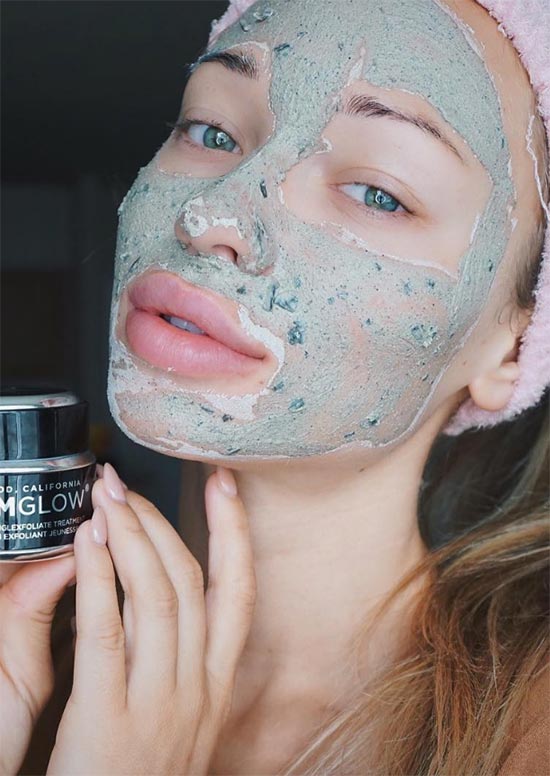
Clay Masks
Clay masks are intrinsically more drying than mud masks. This should not serve as a deterrent, as all of our advice above has proven, but should provide insight into the key difference between the two.
Clay masks absorb impurities and soak up oils from pores, whereas mud masks replenish moisture and boost circulation. Clay has been considered more effective at managing breakouts and improving the appearance of pores.
We certainly advise incorporating mud masks into your skin care routine but not at the exclusion of clay masks. Both can be used to sustain supple and glowing skin. The most effective skin care plan will include the use of clay and mud masks and a nutrient-rich moisturizer.
How to Use a Clay Mask?
If our exposé above has revealed anything, beauty alchemy can be achieved with the use of a clay mask. Convert those clogged pores into refreshed and radiant skin – it sounds magic, doesn’t it?
A large piece of ensuring that you get the most benefits from your clay mask is to nail its application. While it sounds mystical, many experts advise avoiding metal bowls or tools when mixing or blending your clay mask. Wood, glass, and plastic are better suited to clay, as they do not negatively impact the structure or properties of the mask.
Clay masks can be applied liberally but to achieve the most concentrated and strategic results we recommend applying it more specifically to the T-zone area. This facial region consists of the forehead, nose, and chin. This portion of the face is most susceptible to grease and sebum buildup. An application on the cheeks will keep your skin supple and clarified.
Whether you are multi masking or using them alone, don’t use clay masks daily. They are effective when used 1-2 times a week. Using clay face masks more often can lead to irritated skin, while less than that might not give good results.
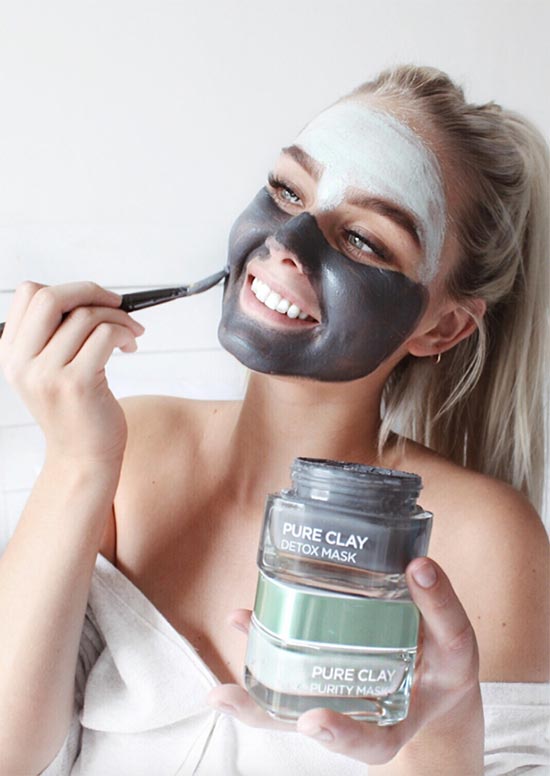
Ensure your face is properly cleansed and free of makeup before applying your clay mask. You want to pat your skin with warm water to relax your pores and make them more amenable to your mask, making it easier for the clay to absorb impurities.
Now here comes the revelatory bit: you should avoid letting the mask completely harden. Beauty experts warn that letting the mask dry to the point where it is flaking off could cause more harm than good and lead to excessive drying and eventual skin irritation.
Upon application the clay mask is damp and infuses the skin with a beneficial exchange of nutrients. When the clay mask dries slightly it begins to absorb oil and impurities, contract the pores, and draw blood to the surface, which improves skin circulation.
After this desirable point the clay begins to crack and harden and actually become detrimental to the skin. It is vital to remove the clay mask before it reaches this hardened point.
Pay close attention to the instructions of your individual clay mask, as most will advise on an ideal application time. Veering on the side of caution we advise skimming a few minutes off of the suggested time, particularly if you have dry or sensitive skin. Oilier skin profiles have more leeway but you should stick to the suggested time nonetheless. Most clay masks cite an application time of 5-20 minutes. Anything longer than this is ill-advised.
To remove your clay mask, use a warm cloth to dab the product off the skin. Do not tug or rub against the clay. Because it is so sturdy when dry, tugging it will create redness and irritation, counteracting the anti-inflammatory properties of the formula.
A gentle, patient hand will be your best defense against this common mistake. Rub the clay off using circular motions to lightly exfoliate and slough away dead skin.
Apply a generous amount of moisturizer but avoid overcompensating if your skin is feeling tight. You want to leave room for your pores to breathe after the removal of the dirt and oils that have been clogging them.
Photos via @sonagasparian, Instagram

